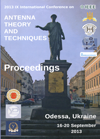Polarization sensitive multipath propagation modeling
DOI:
https://doi.org/10.1109/ICATT.2013.6650834Keywords:
mobile communications, polarization structure of the receiving antenna, random mediaAbstract
The polarization structure research of the receiving antenna excited by arbitrary field is carried out. The necessary ratios, characterizing the optimal polarization antenna's structure are determined by the criteria of maximal and minimal received signal's power. An advantage of received power is estimated for an optimal polarization.References
XIA, H.H.; BERTONI, H.L.; MACIEL, L.R.; LINDSAY-STEWART, A.; ROWE, R. Radio propagation characteristics for line-of-sight microcellular and personal communications. IEEE Trans. Antennas Propag., Oct. 1993, v.41, n.10, p.1439-1447, doi: http://dx.doi.org/10.1109/8.247785.
ALIMOV, V.A.; KOROBKOV, J.S.; MOROZOV, V.I.; MEDVEDEV, V.N.; POZHIDAEV, S.N.; RAKHLIN, A.V.; TUVAEV, E.K. Characteristics of the UHF-signals in the communication channel with mobile objects in the city conditions. Radiotechnika, 1984, n.4, p.21-25.
FUHL, J.; ROSSI, J.-P.; BONEK, E. High-resolution 3-D direction-of-arrival determination for urban mobile radio. IEEE Trans. Antennas Propag., Apr. 1997, v.45, n.4, p.672-682, doi: http://dx.doi.org/10.1109/8.564093.
LEE, W.C.Y. Mobile Communications Engineering. McGraw-Hill Co, 1982.
PROTSENKO, M.B. Polarization-structure analysis of receiving antennas. Microwave Optical Technology Lett., 2001, v.30, n.2, p.116-119, doi: http://dx.doi.org/10.1002/mop.1236.

